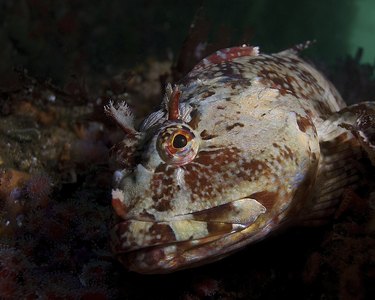
The classic phrase "don't judge a book by its cover" applies to cabazon, a Pacific Coast bottom feeder. Despite its ghastly exterior, this fish has pleasant flavor but is a bit tricky to cook because of large pin bones in the meat. The bones can be removed before or after cooking cabazon. This mild-flavored whitefish takes on the flavors of its seasonings -- similar to cod -- but has dense texture like salmon.
Preparation
Video of the Day
Whole fish are best suited for grilling or broiling, but it is also possible to fry and flip a whole cabazon in a large skillet. The meat flakes off the bones fairly easily when cooked, so whole cooking might be preferred over fileting the fish. Cabazon fillets can be served on individual plates straight from the pan or grill, and the dense texture makes it easy to flip the pieces without them falling apart. Cut small fillets from between the bones, or cut large fillets from the belly and sides, and use pliers to pull out the pin bones from the area around the head and front of the fish. Cabazon's mild flavor makes it suitable for practically any spice combination. For a lighter flavor, season the cabazon with olive oil, lemon juice and fresh ground black pepper. For a spicy kick, season with a Cajun spice blend and hot sauce.
Video of the Day
Grilling
Fish is not always a good candidate for grilling because light, flaky varieties fall apart so easily especially when you attempt to flip them, but dense cabazon holds up well. Add any marinade or spices to the fish at least 30 minutes before grilling. Cut a few X-shaped slits in whole fish to pack marinade and spices inside the fish for greater flavor. Preheat the grill to medium-high heat. Rub the grill grate with some cooking oil such as vegetable oil to help prevent sticking. Grill filets for about 6 to 8 minutes per side, or about 10 minutes per side for whole fish. Increase the cook time as needed until the fish reaches a minimum internal temperature of 145 F and the meat flakes easily. Insert a meat thermometer in the thickest part of the fish to check the temperature.
Oven Cooking
An oven's broiler produces similar results to grilling with heat overhead to develop desired browning or char on the cabazon. Adjust the oven rack so the fish rests about 6 inches below the broiler heating element. Broil the fish for roughly 4 minutes per side for fillets or 8 minutes per side for a whole fish. Cover the fish with aluminum foil to prevent burning. Check with a thermometer to ensure an internal temperature of 145 F. For oven baking, fish generally requires 20 minutes at about 375 F, but a meat thermometer is the best method to ensure it reaches the proper temperature. Bake fillets or whole fish on a foil-lined baking pan. Alternatively, wrap fillets in foil or parchment paper packets with spices and vegetables such as onions and peppers. The fish and veggies steam inside the packets.
Frying
Pan-fried cabazon does not necessarily mean high fat. Breaded or battered fish fried in oil such as vegetable oil or peanut oil has a high fat content, but skip the breading and substitute healthier fat options such as sunflower oil or coconut oil, and cabazon can be prepared in a skillet as part of a healthy diet. Regardless of choice, fried fish requires some type of fat to line the pan and keep the fish from sticking. Preheat the oil and keep the heat at medium to medium-high to avoid burning the cabazon. Fry for about 2 to 3 minutes per side or until the internal temperature reaches 145 F. Whole fish require a longer cook time, and should be flipped once every few minutes to allow for more even cooking and prevent burning one side.
- The Ocean Harvest: Featured Fish: Cabazon (Scorpaenichthys Marmoratus)
- Tacklebuster Sport Fishing: Cabazon
- The Impractical Fishermen: How To Broil Whole Cabazon
- The Ocean Harvest: Cabazon Done
- Bon Appetit: How to Cook Fish Fillets Perfectly Crispy, Without a Recipe
- The Kitchn: How to Cook Fish on the Stovetop
- Betty Crocker: Baked Fish Fillets
- Old Bay: 2-Step Broiled Fish
- FoodSafety.gov: Safe Minimum Cooking Temperatures